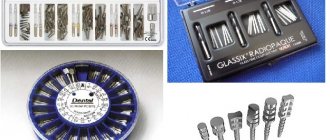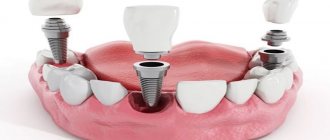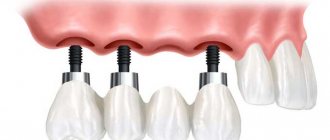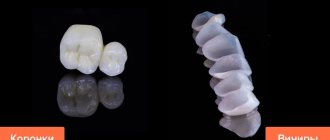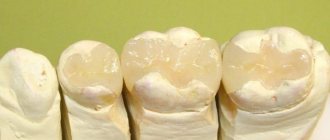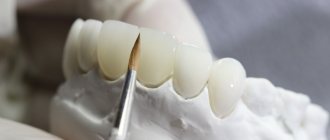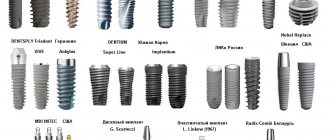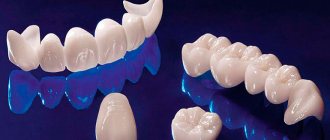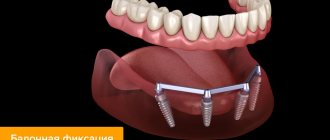If it is necessary to restore a significantly damaged tooth, the dentist does not always suggest simply removing the root and installing an implant instead. In most cases, the patient is offered restoration of the crown on a pin or using a core inlay. Naturally, most people have a completely logical question: “What is the difference between a pin and an inlay?”
The choice of prosthetics on a pin or with an inlay is usually made by the attending physician. At the same time, he is guided by the main pros and cons of a particular type of restoration. We invite you to find out the main advantages and disadvantages of both methods in order to have information that will definitely be useful in the future.
Advantages of restoring teeth with pins
To restore a tooth using a pin, you do not need to clean the tooth very much, because the pin is much thinner than the inlay. Thanks to this, the rods have become somewhat more widely used in dental practice. This is one of the first differences that is mentioned when discussing the difference between a pin and an inlay.
The cost of the procedure for manufacturing and installing a pin is slightly lower than restoring a tooth on an inlay. And in terms of timing, treatment rarely requires more than one visit to the dentist. These undeniable advantages have made the method of restoring dental crowns on pins so popular that it is used everywhere.
What is a dental pin
A dental post is a metal rod with a screw thread. Unlike the tab, it has a standard shape (it differs only in length and diameter). Like stump inlays, the pin is designed to restore a tooth whose crown has been destroyed directly under the root.
The pin is screwed into the root, which must first be cleared of inflammatory processes and sealed. Composite material is applied on top - artistic extension is carried out.
Dental pin
Disadvantages of restoring teeth with pins
Like most procedures, there are disadvantages to pin restoration. When creating such an artificial tooth, there is no chemical connection between the root itself, strengthened by the rod, and the crown, so in some cases, especially after long-term use, the crown may fall off.
Also, if during the procedure the pin material was chosen incorrectly or after the pin was installed, the newly formed tooth began to place a greater load on the bone, this can contribute to root deformation or even its destruction, which can be aggravated by the occurrence of an inflammatory process in the bone. In order to avoid such disadvantages, when screwing the rod into the root, you need to act very carefully and carefully so as not to damage the surrounding tissue.
Advantages of stump inlays:
- two parts of the tab (under and above the gum) are one material, one-piece design, so its separation and damage is impossible, even if the tab is collapsible, its main part is solid:
- the inlay accurately follows the contours of the internal cavity of the tooth:
- minimal load on the walls of the tooth – protection from rapid destruction;
- uniform load on the tooth and tissues around it;
- it is possible to use an inlay even if the tooth root is bent;
- it is possible to use various materials (cobalt-chrome, gold-based alloy, zirconium dioxide), including for patients with an allergy to metals;
- it is possible to achieve unsurpassed aesthetic results when using metal-free inlays, for example, from zirconium dioxide;
- long service life - more than 10 years.
Pros of restoring teeth using inlays
Considering that the stump and the rod that secures it in the root are cast as a single whole, they cannot separate. Thanks to this, the service life of the restored tooth is significantly increased. In the manufacture of the stump, super-strong alloys are most often used - cobalt and chromium, gold and impurities. This makes recovery more reliable.
The wedging effect on the root and surrounding bone tissue is not felt, since the load during the chewing process is transferred not only to the core and root of the tooth, but is also distributed evenly along the axis of the tooth root, since the area of the inlay is much larger than the area of a conventional pin. It is also worth noting that cementing the tab does not put pressure on the root.
Stump inlays: advantages and disadvantages
Core inlays are structures that are created individually for each patient in a dental laboratory. To install them, the nerve of the tooth is first removed, all carious cavities are carefully removed, after which an impression is taken. Based on it, an individual pin is created that fits tightly to the walls of the root. The top of the inlay is covered with a dental crown or composite material. At the same time, fixing the crown to the core tab is the most reliable and durable method of tooth restoration.
Core inlays appeared several decades ago, but did not find much popularity due to the more complex installation process compared to pins and high cost. However, the number of advantages of inlays is many times greater than that of pins, so today they are used much more often.
Disadvantages of restoring teeth with pins
A one-time solution to the problem is impossible. Prosthetics of one tooth on an inlay requires two to three sessions. The fact is that the “pin + inlay” conglomerate is manufactured in a dental laboratory.
When installing an inlay, it is necessary to prepare the tooth more. Not every case has such an opportunity. However, if you clean the tooth well, you can not only prepare a place for the inlay, but also completely eliminate the damaged tissue, which will stop further tooth decay.
And, of course, when talking about the difference between a pin and an inlay, it is worth taking into account the features and duration of the procedure. Based on these parameters, inlay prosthetics will cost more. In any case, as dentists note, despite its disadvantages, this technique is the most acceptable. With the help of inlays it is possible to achieve a reliable, durable and aesthetic result.
Which surgical method is more reliable and durable for a femoral neck fracture?
ENDOPROSTHETICS OR OSTEOSYNTHESIS - which surgical method is more reliable and durable for a femoral neck fracture?
A hip fracture (or fracture of the neck of the femur) can happen at any age. But still, this happens more often in older patients and, to a greater extent, in women over 60 years of age. This is due to the fact that with age, a woman’s bone tissue becomes more fragile. Such changes are associated with a decrease in the production of estrogens, which are involved in the synthesis of bone tissue.
Surgery is the only option for treating a femoral neck fracture in older patients. If the operation is performed by an experienced, knowledgeable surgeon in a short time after injury, then the chances of recovery are very high. The main thing is to choose the right doctor and clinic. It should be noted that conservative treatment methods for older patients are not recommended, since they are not effective and, moreover, are more difficult for these patients to tolerate than surgery.
Why, in the case of a hip fracture, surgery is much more effective than conservative treatment.
Since minerals enter the tissue of the femur through small blood vessels located inside the bones and ligaments, when a fracture or damage to the ligaments occurs, the blood flow in the bone is disrupted, which provokes tissue death. The tissue of the femur begins to deteriorate and does not fuse with other parts. Sometimes small bone fragments are completely resorbed.
Therefore, in case of injuries and fractures of the femoral neck, even young patients are often recommended to undergo total endoprosthetics. It is extremely rare to be able to treat damage to the femur using conservative methods.
Partial or complete endoprosthetics? What is more effective for a hip fracture?
And now the patient is faced with the question: Which method of endoprosthetics is more suitable in case of a femoral neck fracture?
- Partial (unipolar) endoprosthesis replacement is a partial replacement of one of the components of the patient’s joint with an artificial one.
- Total (bipolar) arthroplasty is the replacement of all components of the patient’s joint with an artificial prosthesis.
At first glance, it may seem that partial or unipolar endoprosthetics are a less invasive method of surgery. But it is worth recognizing that such a combination (prosthesis + the patient’s own bone) is less durable in use than the complete replacement of articular components with an artificial prosthesis.
With a partial joint replacement—for example, a femoral neck and head replacement while preserving the natural acetabulum—the patient's own cartilage wears out faster and this combination will more quickly require reoperation.
When total endoprosthetics is used, all components of the joint are replaced with artificial parts. Moreover, the combination of materials of these parts may vary depending on the expected loads, age and lifestyle of the patient. This is done to extend the life of the new prosthesis.
Cemented or cementless endoprosthetics? What's better?
Patients also often ask the question, which is better: cemented or cementless arthroplasty?
When a cementless joint replacement method is used, the surgeon uses a special prosthesis with a porous, rough surface, which, using special instruments, is tightly driven into the patient’s femur and the prosthesis gradually fuses with natural bone tissue. This technique is more suitable for young and middle-aged patients who have healthy bones with good tissue regeneration rates.
The cement method of attaching the burr element of the prosthesis is more often used for patients over 70 years of age. In this case, a special polymer composition (cement) is used to attach the prosthesis to the bone. The main indication for the use of polymer cement is a decrease in the regeneration functions of the patient’s own bone tissue.
Advantages of endoprosthetics for hip fractures
- Thanks to modern minimally invasive methods, there is virtually no blood loss during endoprosthetics surgery and patients do not require a transfusion of someone else’s blood.
- Pain syndrome after surgery decreases and quickly passes. This reduces or completely eliminates the use of potent painkillers and analgesics, which in turn reduces the risk of impaired respiratory function of the patient.
- Short periods of patient stay in hospital.
- Quick return to motor activity and transition to the patient’s usual lifestyle.
- If all conditions for preparing the patient and performing the operation are met, the risk of blood clots and infection is reduced.
What you should pay attention to when planning joint replacement surgery
Modern methods of performing such operations make it possible to minimize complications and risks associated with endoprosthetics. If the patient has undergone high-quality preoperative preparation and examination, and the operation was performed by an experienced surgeon, then we can hope that after 2-3 months the person can return to his usual lifestyle, significantly improving his quality of life.
Types of femoral osteosynthesis
The surgical manipulation consists of fixing bone fragments in an anatomical location using specialized metal fasteners. It is considered an intervention with the most favorable prognosis; moreover, recovery takes little time - sometimes less than a week.
Osteosynthesis is classified into two subtypes: extramedullary and intramedullary.
The first involves external fixation of bone fragments without introducing metal into bone structures using titanium plates and rings. In the second option, a long metal pin is inserted into the medullary canal of the bone. Combined methods combining two subtypes are also used.
According to the scheme, there are open and closed methods of intervention. In the first case, the affected bones are completely exposed and fixed in the required position using plates or by introducing screws and rods to prevent deformation. As a rule, open osteosynthesis is intraosseous. The closed method involves connecting bone fragments through small holes to block subsequent displacement. In this case, short pins are used.
